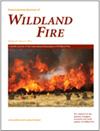死燃料含水率简单经验模型的评估和比较
IF 2.9
3区 农林科学
Q1 FORESTRY
引用次数: 0
摘要
背景 枯落物和木质碎屑的含水量是决定火势和火灾行为的关键因素。因此,获得死细燃料(即 1 小时和 10 小时燃料)含水量的可靠估计值是有效火灾管理的关键要求。目的 我们评估并比较了五个燃料含水量简单模型的性能。这些模型分为两类:(1) 蒸气压差的指数函数;(2) 空气温度和相对湿度(加权)差值的仿射函数。方法 通过对四个经验数据集进行交叉验证,使用误差和相关性统计来评估模型性能。主要结果 总体而言,性能最好的模型是基于温度和相对湿度加权差值的宽松模型和广义模型。结论 空气温度和相对湿度之差的简单函数与蒸汽压力不足的指数函数具有同样甚至更好的性能。不过,在应用于含水量小于 10% 的燃料时,必须注意所有这些模型的局限性。意义 使用易于应用的简单模型可以可靠地估算出细枯燃料和木质碎屑的含水率。本文章由计算机程序翻译,如有差异,请以英文原文为准。
Evaluation and comparison of simple empirical models for dead fuel moisture content
Background The moisture content of litter and woody debris is a key determinant of fire potential and fire behaviour. Obtaining reliable estimates of the moisture content of dead fine fuels (i.e. 1-h and 10-h fuels) is therefore a critical requirement for effective fire management. Aims We evaluated and compared the performance of five simple models for fuel moisture content. The models belong to two separate classes: (1) exponential functions of the vapour pressure deficit; and (2) affine functions of the (weighted) difference between air temperature and relative humidity. Methods Model performance is assessed using error and correlation statistics, calculated using cross validation, over four empirical datasets. Key results Overall, the best performing models were the relaxed and generalised models based on the weighted difference between temperature and relative humidity. Conclusions Simple functions of the difference between air temperature and relative humidity can perform as well as, if not better than exponential functions of vapour pressure deficit. However, it is important to note the limitations of all these models when applied to fuels with moisture contents <10%. Implications The moisture content of fine dead fuels and woody debris can be reliably estimated using simple models that are amenable to easy application.
求助全文
通过发布文献求助,成功后即可免费获取论文全文。
去求助
来源期刊
CiteScore
5.50
自引率
9.70%
发文量
67
审稿时长
12-24 weeks
期刊介绍:
International Journal of Wildland Fire publishes new and significant articles that advance basic and applied research concerning wildland fire. Published papers aim to assist in the understanding of the basic principles of fire as a process, its ecological impact at the stand level and the landscape level, modelling fire and its effects, as well as presenting information on how to effectively and efficiently manage fire. The journal has an international perspective, since wildland fire plays a major social, economic and ecological role around the globe.
The International Journal of Wildland Fire is published on behalf of the International Association of Wildland Fire.

 求助内容:
求助内容: 应助结果提醒方式:
应助结果提醒方式:


